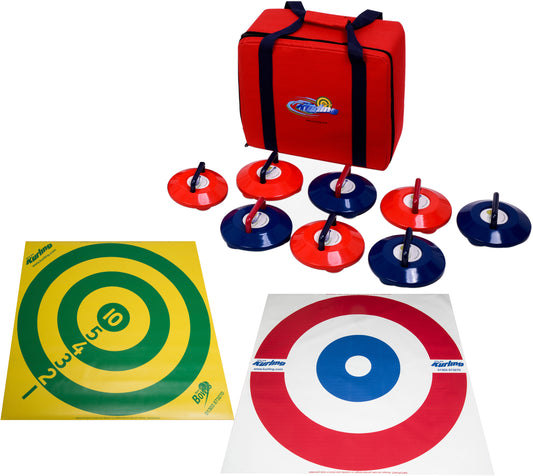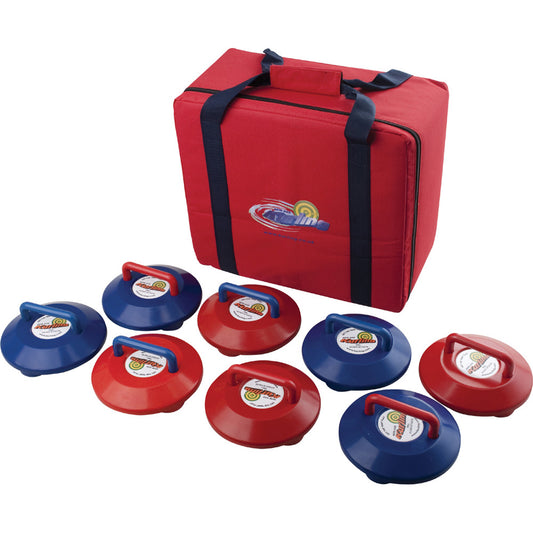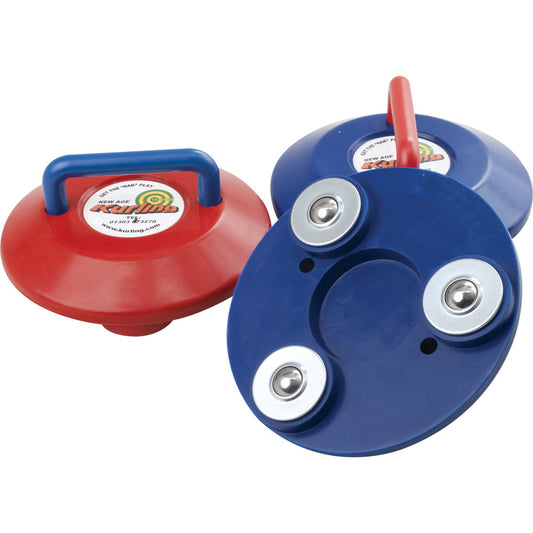


In Conversation With... Kev Weir
We’re excited to launch our new teacher interview series with Kev Weir, a passionate Primary PE Lead and Sports Coach. Kev is on a mission to make PE inclusive, engaging, and fun for every pupil – and he’s built a thriving online community to help others do the same.
You might know him from Instagram (@just.playsports) or TikTok (@justplaysports), where he shares daily coaching tips, creative PE ideas, and a whole lot of encouragement for fellow educators.
We caught up with Kev to hear his thoughts on what makes great PE and why inclusivity is key.
Can you walk us through your career journey so far?
Like many kids growing up, I had dreams of becoming a professional footballer, until I realised that a decent first touch and a dodgy knee weren’t exactly the golden ticket to the Premier League. So, I did the next best thing: I became a PE teacher.
I’ve always loved all things PE, not just the sport itself, but the sense of belonging and confidence it can build in young people. I wanted to give every child that same experience, minus the dodgy knee.
My journey began in a primary SEND school, which was a brand-new site at the time, basically a blank canvas with no PE programme in place. It was the perfect opportunity to create something meaningful from scratch. Our focus was making sure every child, regardless of ability or background, could experience success in PE. Seeing pupils who had previously disliked school light up when it was time for PE was genuinely special, and a solid reminder that PE, when done right, is about so much more than just playing sports.
Fast forward to today, and I’m leading PE in a mainstream primary school. My mission remains the same, to make PE a positive, inclusive experience for all pupils, not just the ones who can perform a cover drive or score into the top corner from 30 yards.
The biggest shift I’ve seen in the last 12 years is that PE is finally being recognised as more than just sport. It’s about physical literacy, confidence, connection, and fun.
What’s a moment in your PE teaching career that really stuck with you — and why?
Without a doubt, one of the proudest moments in my career was transforming Sports Day at a SEND school into the event of the year, not just for the students, but for the staff too.
The aim was simple: make it inclusive, make it joyful, but don’t shy away from a little healthy competition. There’s this long-running debate in education about whether competition belongs in school sport, especially in SEND settings, but I’ve always believed that everyone deserves the chance to experience competition if set out in an appropriate manner.
We created an event where every child could participate and shine, whether that was in a relay, a beanbag toss, or coming up with solutions in a co-operative task.
What makes it all even more special is that years later, I’ve seen some of the students I have previously taught who are still actively involved in sport. A few have even gone on to college or university to pursue careers in teaching or coaching themselves. It’s like the full circle moment that every educator quietly hopes for. Proof that those early experiences do stick, and that PE can be the spark that lights a lifelong passion.
What’s one piece of kit you couldn’t live without in your PE cupboard — and why?
Without hesitation, pool noodles. Criminally underrated here in England, meanwhile, in the US, they’ve got them in every PE lesson like it’s part of the curriculum.
When I first moved my personal collection into the PE cupboard, it raised a few eyebrows. I had staff and students looking at me like I’d either lost the plot or was preparing for a swimming lesson. Pool noodles are incredibly versatile, you can use them for tagging games, obstacle courses, striking, agility work, balance challenges, and more. They're colourful, lightweight, and just chaotic enough to keep things exciting (within reason, of course, no, you can't use them to whack your partner round the head, even if they “started it”).
The best part is they spark creativity. Kids suddenly see a noodle and want to invent something new, and that’s exactly what PE should be about: engagement, imagination, and a little bit of organised chaos.
"Kids suddenly see a noodle and want to invent something new, and that’s exactly what PE should be about: engagement, imagination, and a little bit of organised chaos."

"Kids suddenly see a noodle and want to invent something new, and that’s exactly what PE should be about: engagement, imagination, and a little bit of organised chaos."

What’s the biggest challenge PE teachers face today — and how do you try to tackle it?
From a primary school perspective, one of the biggest challenges we face isn’t a lack of funding or resources, in fact, we’re incredibly fortunate to have received substantial financial backing from the government to enhance PE and school sport. Equipment, CPD, and support are more accessible than ever.
Despite all the backing, PE often finds itself squeezed out by competing curriculum priorities. The recommended two hours of high-quality PE each week can easily become an afterthought when pressures around literacy, maths, and assessments take centre stage. And on top of that, there’s still a lingering misconception that PE is just “running around” or that it’s only for the sporty kids.
The way forward starts with changing that narrative. We need to keep sharing the message that PE is so much more than sport. It’s about physical and mental health, teamwork, leadership, resilience, and even academic performance. A well-planned, inclusive, and meaningful PE curriculum doesn’t take time away from learning, it enhances it.
If school leaders and staff can truly see the wider impact of quality PE, not just on children’s bodies but on their confidence, focus, and wellbeing, then we’ll be in a much stronger position to give it the time and value it deserves.
What changes have had a big impact on inclusion in your lessons?
One of the biggest changes I’ve made is how I communicate with students. With attention spans getting shorter, thanks to endless short-form content and the ability to skip adverts over 5 seconds, I’ve had to seriously refine how often I speak, and how I deliver instructions. Rather than overloading students with long explanations, I aim for short, sharp, purposeful guidance. But one of the biggest game-changers for inclusion came when I stopped explaining the game altogether.
Instead, I created simple, visual game cards for each group, each card included the equipment list, setup diagram, and rules. I handed them out, said, “Off you go,” and stepped back. Students worked together to set up, interpret the task, and start playing. It gave them ownership, encouraged problem-solving, and allowed them to learn by doing, not just listening.
Not only did it massively boost engagement, but it also created space for every child to contribute in a way that suited them. It’s one of the most inclusive strategies I’ve used.
If you had to use three words to describe your approach to teaching PE, what would they be?
Holistic: For me, PE isn’t just about running laps or scoring goals. It’s about the whole child, their physical, emotional, and social development. I want every lesson to build confidence, encourage teamwork, and promote a lifelong love of movement. It’s not just about creating athletes; it’s about nurturing happy, healthy humans.
Engaging: If it’s not fun, they’re not learning. I’m always looking for ways to make lessons exciting and meaningful, whether that’s through small-sided games, creative challenges, or even a well-timed pool noodle. When students are engaged, they participate fully, take risks, and enjoy the process, which is what it’s all about.
Creative: PE should never feel like the same old activities. I love using equipment in unexpected ways, adapting games to suit all learners. Creativity keeps me on my toes and keeps students curious, enthusiastic, and involved in what's going to happen next.

What's your secret to engaging reluctant or less confident students to get involved in PE?
For me, it’s all about making PE feel less like PE, especially for those students who don’t see themselves as “sporty.” I love using themed games that tap into their interests. Instead of just saying, “We’re doing a dribbling game,” I frame it like, “We’re using our speed like Sonic to escape Dr. Eggman.” Suddenly, it’s not a skill practice; it’s a mission, and even the most reluctant movers are in.
Another key is giving students ownership. Whether that’s letting them choose teams, help set up equipment, or lead warm-ups, involving them in the process boosts their confidence and sense of belonging.
I also make great use of small-sided games. Fewer players means more touches, more chances to succeed, and less pressure. And by using the STEP principles (Space, Task, Equipment, People), I can adapt activities to ensure every child, regardless of ability, can experience some form of success.
How do you handle rainy or bad weather days when outdoor activities aren't possible?
I try to stay as close to the original learning objectives as possible rather than defaulting to dodgeball or benchball just to fill time. There’s always a temptation to throw out a few foam balls and hope for the best, but I’ve found that keeping structure and purpose is key, even indoors.
One standout lesson from our target games unit was New Age Kurling. It’s inclusive, tactical, and keeps everyone engaged, even in the smallest of spaces.

New Age Kurling Combi Bundle
Shop Kurling

New Age Kurling Combi Bundle


Kurling Stones Set

Kurling Telescopic Pushers (per pair)
What's your go-to song or playlist for PE lessons?
Music is a huge part of how I deliver PE. It’s more than just background noise, it’s a timer, a motivator, and a great tool for setting the energy of the lesson. That said, finding songs without explicit lyrics these days feels like a full-time job in itself.
I try to keep it varied and let students have a say in what we play when we can. Giving them that bit of ownership always boosts engagement and occasionally introduces me to something that isn’t just APT on repeat.
So, no fixed playlist, just a constantly evolving playlist that keeps everyone moving - and occasionally groaning at my questionable DJ skills
What’s one thing you’d love to add to your PE curriculum if there were no restrictions?
If money and space were no object, I’d invest in state-of-the-art, inclusive play equipment that blends physical activity with a touch of technology - think interactive climbing walls, sensor-based movement games, and smart play zones that respond to sound, light, and motion.
The goal would be to create a space that gets every child moving, whether they love sport, play, challenge, or just exploring.
Of course, all of it would be fully inclusive, adaptable for different abilities and needs, with sensory features, varied challenge levels, and multiple ways to play. It would bring together everything I love about PE: creativity, engagement, movement, and the chance for every child to feel successful.
What’s your favourite memory from your own school days?
Without a doubt, the legendary lunchtime football matches between the X and Y tutor groups back in secondary school. 15-a-side chaos played on a tarmac pitch that would put some of our roads here in the UK to shame.
Full-on mayhem until someone slotted in a last-minute winner before the bell went - then we would all have to head back to class, sweaty and out of breath. These games were bigger than the World Cup Final.
Who was your most memorable teacher and why?
That would have to be Mr. Richardson, my old Head of PE. I always enjoyed sport growing up, but I never really saw myself as someone who was particularly good at it. Mr. Richardson changed that. He believed in me when I didn’t quite believe in myself.
He gave me opportunities to represent the school in a range of sports, not just the obvious picks, which gave me a real sense of belonging and confidence. But what really stuck with me was how he went above and beyond the usual teacher role. He arranged for me to do extra work experience in the PE department, outside of the standard school placement, which gave me my first real glimpse of what it was like to be on the other side.
That early encouragement and trust planted the seed for my own journey into PE teaching. He saw something in me before I did, and that’s something I’ll never forget.
If you became education secretary tomorrow, what is the first thing you would do?
I'd make sure every primary school had a dedicated PE teacher, and support staff who specialise in delivering high-quality, inclusive physical education.
I’d also provide transport funding so schools can attend local festivals, fixtures, and community events without needing to seek help from parents, fundraise, or not attend at all. Opportunities outside of school are just as valuable as what happens in lessons.
Most importantly, I’d protect the minimum two hours of PE each week so it can’t be traded out for extra maths, SATs prep, or last-minute assemblies. It deserves the same respect and time as every other subject.
What are some personal goals you have for the future, both in and out of the classroom?
Professionally, my goal is for our school to be recognised as one of the leading providers of PE, not just within our catchment area, but beyond. In a relatively short space of time, we’ve already made great strides: hosting CPD events, running regular intra-school competitions, and giving a large number of children the chance to represent the school at festivals and fixtures. But for me, the most important measure of success is, I want every child on our large site to genuinely look forward to PE. If we can create an environment where every student feels excited, included, and motivated to move, that’s real impact.
Personally, I want to continue growing and developing the work I do outside of school. I’m fortunate to have built a following of over 360,000 teachers and coaches on social media, where I share ideas, tips, and resources for delivering fun, meaningful PE, and coaching sessions. That platform has opened doors I never expected, allowing me to connect with educators from around the world, see PE through different lenses, and build a global network of passionate practitioners. My aim is to keep expanding that side of my work, developing new content, collaborating on projects, and ultimately helping raise the profile of PE on a bigger scale.
What’s the best bit of advice you’ve ever received as a teacher?
Well, apart from being strongly advised not to become a teacher, the best bit of advice I’ve ever received is simple but powerful from Mrs Griffiths in my earliest of days:
“Meet them where they are.”
It’s a reminder that every child comes to your lesson with a different set of experiences, emotions, and abilities - and this can look different, each day, for each child. That advice has shaped everything I do in PE, from how I plan lessons, to the language I use, to the way I celebrate effort over outcome.




